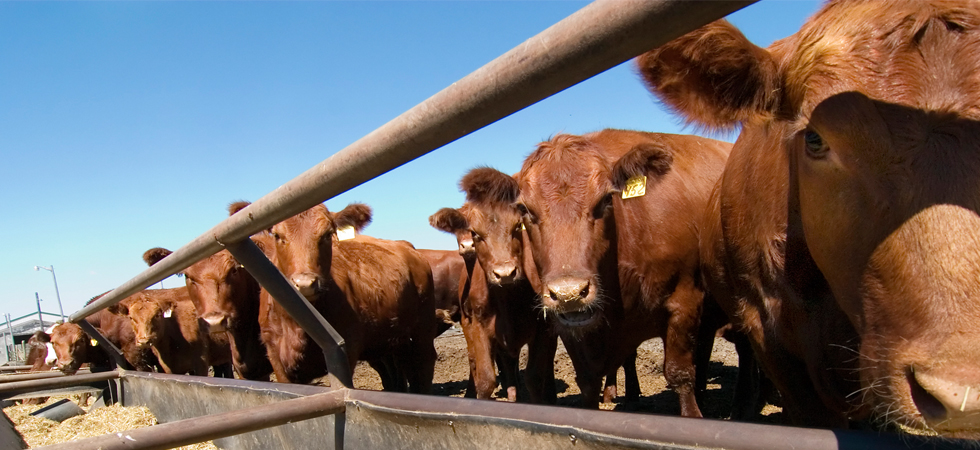 Bovine respiratory disease (BRD) complex is the most common
cattle disease in North America. It’s also the most costly, with total economic
impact valued anywhere from $1 billion to $3 billion annually. Impact to the
average beef cattle operation is about $15/calf/year. In feedlots, BRD accounts
for as much as 80 percent of sickness and 75 percent of death loss. With
potential consequences that high, it’s in the best interest of all producers to
prevent this costly disease.
Bovine respiratory disease (BRD) complex is the most common
cattle disease in North America. It’s also the most costly, with total economic
impact valued anywhere from $1 billion to $3 billion annually. Impact to the
average beef cattle operation is about $15/calf/year. In feedlots, BRD accounts
for as much as 80 percent of sickness and 75 percent of death loss. With
potential consequences that high, it’s in the best interest of all producers to
prevent this costly disease.
BRD, or pneumonia in cattle, is a complex involving several pathogens. Viruses that cause BRD include bovine herpesviruses (IBR), bovine parainfluenza virus (PI-3), bovine respiratory syncytial virus (BRSV), bovine diarrhea virus (BVD), and bovine coronavirus (BCV). Common bacterial agents include Mannheimia haemolytica, Pasteurella multocida, Histophilus somni, and Mycoplasma spp. Lungworms can also be associated with BRD.
Management is Key
The best management programs for BRD combine a good vaccine program with a strong focus on improving overall health while reducing stress. Stressors, like shipping, weaken the immune system just enough to allow the opportunistic bacterial agents that cause BRD to trigger a respiratory infection. That’s why this disease complex is commonly known as shipping fever.
BRD prevention should actually start at birth. Whether or not a calf receives enough quality colostrum at birth dictates his health for the rest of his life. Making sure every calf has colostrum is built-in BRD insurance. It’s a good idea to keep colostrum replacer or supplements on hand during calving. That one calf that didn’t get enough colostrum could be the one that later gets sick and infects all his pen mates right before the sale.
Vaccinate
Two weeks prior to weaning, calves should receive their first shot of a BRD vaccine. A good vaccine given at the right time can do wonders for BRD prevention. In calves, it’s best to vaccinate two weeks prior to weaning to allow an immunity to develop prior to the stress that weaning causes. Calves should then be boostered according to vaccine label instructions. There are several good options available for BRD vaccines. Some of the most common are the Bovi-Shield Gold vaccines, Triangles, and Vista 5’s.
When calves receive this first inoculation it’s a good time to castrate and dehorn them, too. If you wean 30 days prior to shipping you will have the chance to booster the calves two weeks or more prior to shipping, the biggest BRD trigger. Calves weaned well before shipping are also generally bunk broke, which means they are at a better weight. Underweight animals are more susceptible to diseases like BRD.
Environmental Factors
While preconditioned calves are better equipped to battle diseases like BRD, there are a host of environmental factors to pay attention to. Transport seems to be the biggest risk factor for BRD, hence the name shipping fever. A study done at 21 U.S. feedlots over more than 10 years showed distance traveled during shipping was directly related to BRD incidence, average daily gain, and hot carcass weight.
The likelihood of BRD problems increases the more calves comingle, such as in auction barns. Weather is another factor, with temperature and wind chill during transport having the biggest impact. Housing that is overcrowded, damp, or dusty can make animals susceptible to a BRD infection. Finally, nutritional factors such as feedlot rations, dehydration, and bodyweight play a role.
Symptoms and Treatment
While we’re always aiming to prevent diseases like BRD sometimes animals get sick despite our best practices. Typically, sick feedlot animals will exhibit signs of BRD within two weeks of arrival. Often they separate themselves from the herd and show a nasal discharge or loss of appetite. A body temperature above 104 degrees is a good measurable, clinical sign.
If signs of BRD are observed and a high body temperature is present it is important to move that animal to the sick pen as soon as possible. Respiratory disease can spread through a group of animals very quickly. Treatment with an antibiotic at the first signs of infection is extremely important. However, because we don’t know which pathogen is infecting the lungs we can’t be certain the antibiotic will have the desired effect. For this reason, it’s important to recheck cattle during post-treatment.
If an antibiotic isn’t fighting the specific bug causing your problem it doesn’t matter if that drug lasts seven or 10 days. A recheck the day after treatment should tell you if the animal is recovering and if the body temperature has come down. If the temperature remains above 104 degrees it may be necessary to give a different antibiotic. A lot of producers also choose to give a non-steroidal anti-inflammatory (NSAID) like banamine at this time. NSAIDs are useful for keeping the animal comfortable and potentially decreasing the impact of the disease on gain but they do not treat the condition. Keep animals in the hospital pen until all signs of illness disappear and the body temperature returns to normal.
BRD is a costly disease and, while prevention is always the best medicine, a variety of treatment options are available. If you work to develop a good vaccination protocol where vaccines are given at the right time, pay attention to environmental stress factors, and observe your cattle on a daily basis you’ll tremendously decrease the impact of this disease on your operation.
Additional Reading:
Beef Cattle Research Council - "Bovine Respiratory Disease"
Michigan State's Antimicrobial Resistance Learning Site - "Antibiotics & Bovine Respiratory Disease"
Drover's Cattle Network - "BRD Prevention, Treatment, and Immunology"
